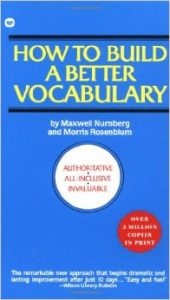
Source: amazon.com
On November 7, 1995, my dad gave me my own copy of one of his favorite books, How to Build a Better Vocabulary by Maxwell Nurnberg and Morris Rosenblum. We still talk about the book’s explanation of the histories behind words like desultory and antimacassar. I had no idea just how profoundly that gift would influence me. This book—along with my dad’s enthusiastic influence—instilled in me a love of words: putting words together, playing with words, making words meaningful. The pages of my copy of the book have yellowed, but my love of words has not.
I know that, unfortunately, not every one of my students will feel the same way about words that I do. Many students come to college feeling that their writing skills are inadequate. They may feel like they’ve always been bad at writing and that they’ll always be bad at writing. As a composition instructor, I feel it’s my responsibility to change that mindset—to help my students realize that, as Joseph Williams says, “it is good to write clearly, and anyone can” (4, emphasis mine).
A great teacher is one who inspires confidence. As I think of the many excellent teachers I’ve had over the years, I can think of one striking commonality among them: they loved what they taught, and they shared their joy with their students. A teacher’s deep interest in a subject sparks a can-do attitude in others. A few weeks ago, a student paid me the finest compliment I’ve ever received as an instructor, saying, “I can tell you love what you do.” When I stand in front of a class of undergraduate students now, I hope I can share the excitement I have about the subject matter with all of my students and maybe even help some of them become passionate about it as well.
But as important as it is to have a love for our subject matter, it’s even more essential to have a deep interest in helping students succeed. I can help students rise to their full potential by making my own writing process transparent, letting them know that—like them—I’m a practicing writer as well. There’s a reason we use that word—practice. It is the mark of a professional to never stop practicing, just as doctors “practice” medicine and lawyers “practice” law. As a composition instructor, I want my students to feel confident in my ability to lead the class, but I never want them to forget that I’m practicing right along with them, that writing is a process, not an end, and that the true joy of writing—the real discovery of it all—is found in that process.
However, focusing on the process can be difficult when grades are such a concern. That’s why I see such value in the writing portfolio as a pedagogical tool. The portfolio provides students the opportunity to revise their work—to polish and groom their ideas into something much greater than they were to begin with. Giving students the opportunity to get feedback on their writing and then to revise their work over the course of many weeks demonstrates real value to them and, I hope, shows them just how rewarding a well-composed final paper can be.
In addition to having a passionate and process-oriented approach, I’ve also learned that my work in the classroom must be supported by a strong theoretical foundation. Glenn and Goldthwaite’s work on evaluating student essays taught me that blanketing a paper with marks and corrections is overwhelming to a student and not helpful in the end (133–134). I learned this firsthand when, after asking a student if he had seen my comments on his evaluated paper, he told me that he read “only the first couple.” I thought I was doing him a favor by pointing to as many areas for improvement as possible, but, instead, I found evidence to support Glenn and Goldthwaite’s recommendation to be judicious with the number of comments I give. Along these same lines, Wildenhain-Belant’s article invited me to rethink my attitudes on grades and what they mean in the composition classroom, and to focus as much as possible on the development of a written project rather than on a final, unchangeable product (35–40). And I found Paton’s article insightful as it emphasized the importance of preparing students for collaborative learning, instead of just assuming that every student has the same understanding of how such learning works (290–301). All of these ideas were new to me just a few months ago. It’s encouraging to think of all I’ve learned to this point, yet it’s sobering to think of how much I still don’t know.
I know there’s a lot I can do to improve as a teacher, and I’m excited to continue practicing. I’m looking forward to next semester to see how the knowledge I’ve gained during my first semester at Iowa State can influence the way I teach in the future.
Works Cited
Glenn, Cheryl, and Melissa A. Goldthwaite. “Evaluating Student Essays.” The St. Martin’s Guide to Teaching Writing. 7th ed. Boston: Bedford/St. Martin’s, 2014. Print.
Paton, Fiona. “Approaches to Productive Peer Review.” 290–301. Print.
Wildenhain-Belant, Mary Kay. “Bridging the Chasm Between Philosophies: A Novice Composition Instructor’s Thoughts on Evaluation and Grading.” Language Arts Journal ofMichigan Spring/Summer (2005): 35-40. Print.
Williams, Joseph M. Style: Ten Lessons in Clarity and Grace. 8th ed. New York: Pearson Longman, 2005. Print.